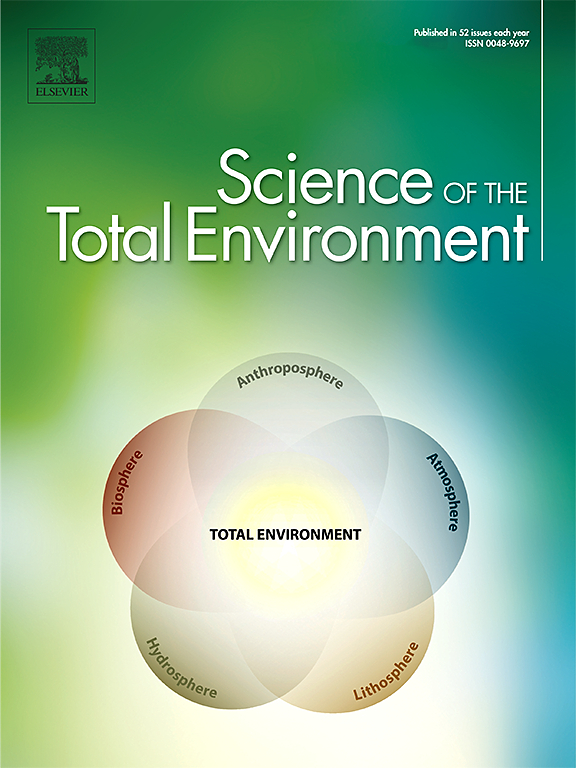Source-tracing of industrial and municipal wastewater effluent in river water via fluorescence fingerprinting
IF 8.2
1区 环境科学与生态学
Q1 ENVIRONMENTAL SCIENCES
引用次数: 0
Abstract
Fluorescence fingerprinting is a technique to uniquely characterize water samples based on their distinct composition of dissolved organic matter (DOM) measured via 3D fluorescence spectroscopy. It is an effective tool for monitoring the chemical composition of various water systems. This study examines a river affected by several municipal and industrial wastewater treatment plant (WWTP) effluents and aims to source-tracing them via fluorescence fingerprints based on parallel factor analysis (PARAFAC) components. Additional principal component analysis (PCA) clusters the WWTP effluents according to similarity. The results yield seven PARAFAC components characterizing the WWTP effluents. Considering the ratios among the components, these distinct fluorescence fingerprints are attributable to the studied industrial sectors: leather industry, meat processing, electronics industry, and municipal wastewater treatment. Furthermore, the fluorescence signal of the receiving river is examined by PCA and assessment of flow-weighted fluorescence intensities for source-tracing the fingerprints of the WWTP effluents. An analysis of the contribution of each WWTP effluent shows that during low flow, the fluorescence signal in the river is dominated by WWTP emissions. In contrast, during high flow events, the impact of WWTP emissions is masked by diffuse emissions. The techniques presented in this study have the potential to define generalizable fluorescence fingerprints for WWTP effluents of various industrial sectors and source-trace them in the receiving river. This approach represents a step closer to implementing complex fluorescence monitoring tools in rivers, tracing the impact of municipal and industrial WWTP effluents on riverine OM.

利用荧光指纹技术追踪河流中工业和城市污水的来源。
荧光指纹是一种通过三维荧光光谱测量水样中溶解有机物(DOM)的独特组成来独特表征水样的技术。它是监测各种水系化学成分的有效工具。本研究以一条河流为研究对象,考察了受多个城市和工业污水处理厂(WWTP)污水影响的河流,并旨在通过基于平行因子分析(PARAFAC)成分的荧光指纹来追踪它们的来源。附加主成分分析(PCA)根据相似性对污水处理厂污水进行聚类。结果得出了七个表征污水处理厂废水的PARAFAC成分。考虑到成分之间的比例,这些不同的荧光指纹可归因于所研究的工业部门:皮革工业,肉类加工,电子工业和城市污水处理。此外,采用主成分分析法和流量加权荧光强度评估对接收河流的荧光信号进行检测,用于追踪污水处理厂出水指纹的来源。通过对各污水处理厂出水贡献的分析可知,在低流量时,河流中的荧光信号以污水处理厂排放为主。相反,在高流量期间,污水排放的影响被漫射排放所掩盖。本研究中提出的技术有可能为各种工业部门的污水处理厂废水定义通用的荧光指纹,并在接收河流中对其进行来源追踪。这种方法代表着在河流中实施复杂的荧光监测工具,追踪城市和工业污水处理厂废水对河流OM的影响的又近了一步。
本文章由计算机程序翻译,如有差异,请以英文原文为准。
求助全文
约1分钟内获得全文
求助全文
来源期刊

Science of the Total Environment
环境科学-环境科学
CiteScore
17.60
自引率
10.20%
发文量
8726
审稿时长
2.4 months
期刊介绍:
The Science of the Total Environment is an international journal dedicated to scientific research on the environment and its interaction with humanity. It covers a wide range of disciplines and seeks to publish innovative, hypothesis-driven, and impactful research that explores the entire environment, including the atmosphere, lithosphere, hydrosphere, biosphere, and anthroposphere.
The journal's updated Aims & Scope emphasizes the importance of interdisciplinary environmental research with broad impact. Priority is given to studies that advance fundamental understanding and explore the interconnectedness of multiple environmental spheres. Field studies are preferred, while laboratory experiments must demonstrate significant methodological advancements or mechanistic insights with direct relevance to the environment.
 求助内容:
求助内容: 应助结果提醒方式:
应助结果提醒方式:


